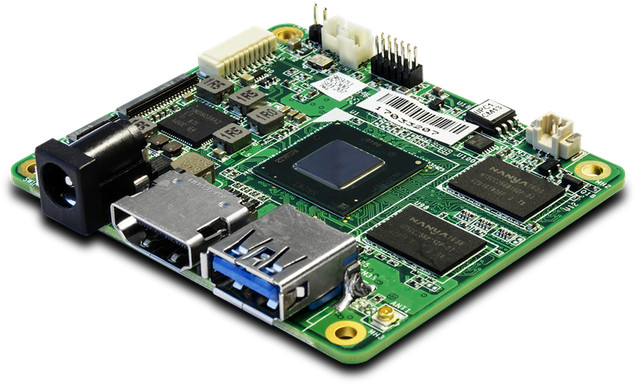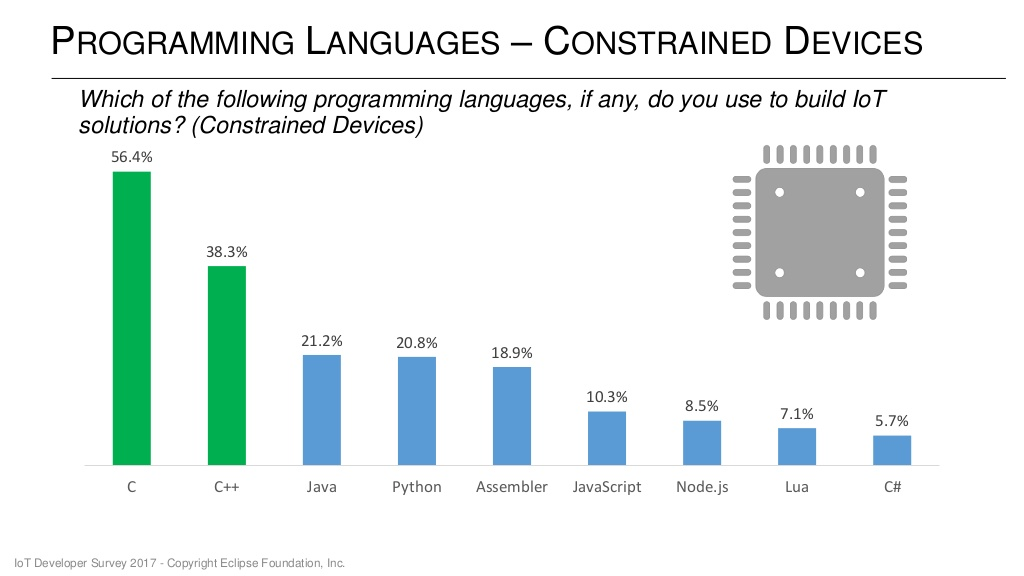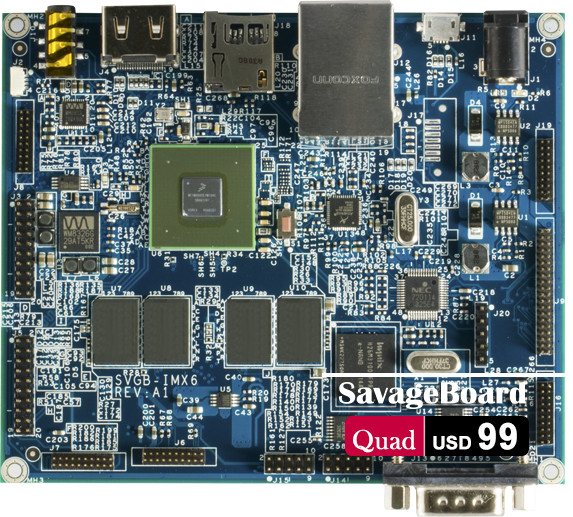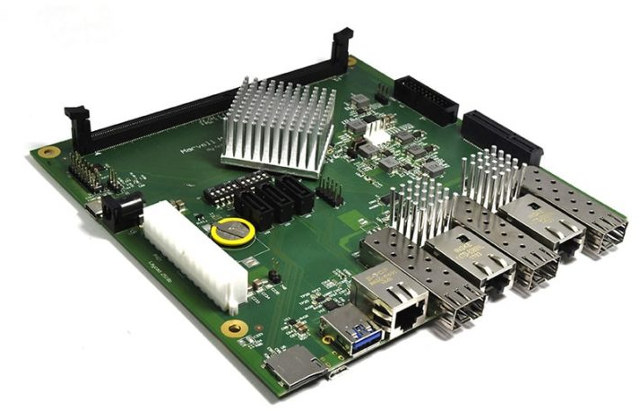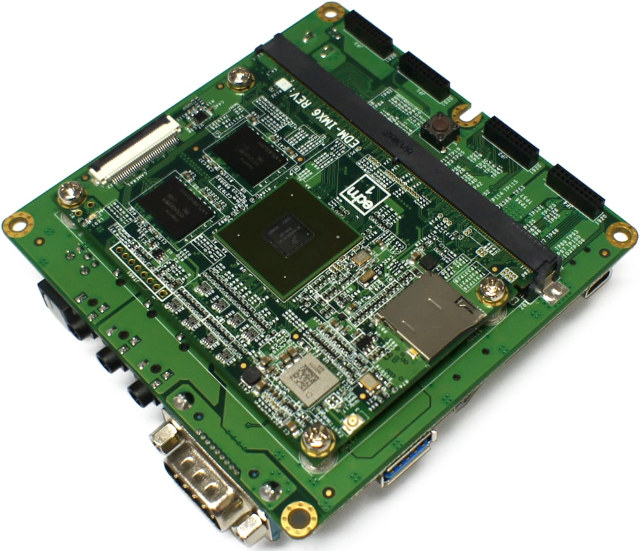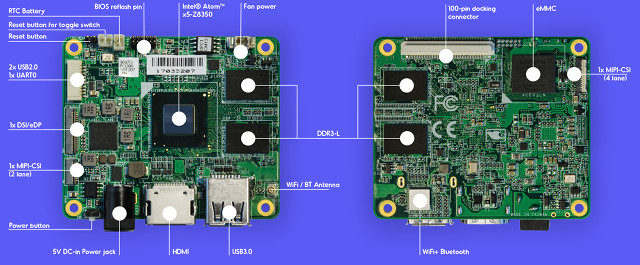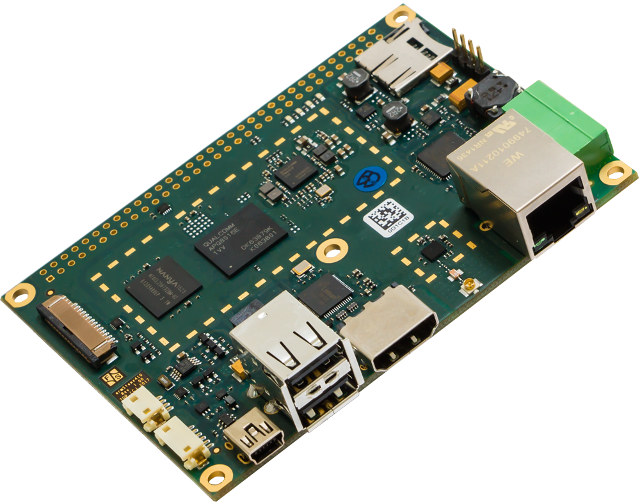During spring, we discovered UP Core, a tiny board powered by Intel x5-Z8350 Cherry Trail processor that promised to sell for as low as 69 Euros. But at the time, it was not available yet for purchase, and the good news is that UP has just launched a one month crowdfunding campaign on Kickstarter to raise funds for mass production, and promote the board. UP Core specifications have not changed since the first announcement: SoC – Intel Atom x5-Z8350 “Cherry Trail” quad core processor @ 1.44 GHz / 1.92 GHz (Burst frequency) with Intel HD 400 graphics @ 200 / 500 MHz System Memory – 1, 2 or 4 GB DDR3L-1600 Storage – 16, 32, or 64 GB eMMC flash, SPI flash ROM Video Output / Display – HDMI 1.4 port, full eDP (embedded DisplayPort) connector Audio I/O – Via HDMI, and I2S Connectivity – 802.11 b/g/n WiFi @ 2.4 […]
Top Programming Languages & Operating Systems for the Internet of Things
The Eclipse foundation has recently done its IoT Developer Survey answered by 713 developers, where they asked IoT programming languages, cloud platforms, IoT operating systems, messaging protocols (MQTT, HTTP), IoT hardware architectures and more. The results have now been published. So let’s have a look at some of the slides, especially with regards to programming languages and operating systems bearing in mind that IoT is a general terms that may apply to sensors, gateways and the cloud, so the survey correctly separated languages for different segments of the IoT ecosystem. C and C++ are still the preferred languages for constrained devices, and developers are normally using more than one language as the total is well over 100%. IoT gateways are more powerful and resourceful (memory/storage) hardware, so it’s no surprise higher level languages like Java and Python join C and C++, with Java being the most used language with 40.8% […]
SavageBoard Open Source Hardware Board Powered by NXP i.MX 6 Processor Offers Multiple Display Options
While it’s hard to keep track of all NXP i.MX6 boards and modules on the market, few can claim to be open source hardware, with the exception of OpenRex, and now SavageBoard, which I just found in Linux 4.11 release log. The board comes in three variants with Solo, Dual, and Quad versions, is equipped with 4 to 8GB flash, 512MB to 1GB RAM, HDMI, TFT LCD, MIPI DSI, and LVDS ports, Ethernet, SATA (Quad only), lots of I/O headers, and more. SavageBoard Solo/Dual/Quad specifications: SoC Solo – NXP i.MX 6Solo Cortex A9 processor @ 1.0 GHz with Vivante GC880 3D GPU Dual – NXP i.MX 6Dual dual core Cortex A9 processor @ 1.0 GHz with Vivante GC880 3D GPU Quad – NXP i.MX 6Quad quad core Cortex A9 processor @ 1.0 GHz with Vivante GC2000 3D GPU System Memory Solo – 512 MB 32-bit DDR3 @ 400 MHz Dual […]
SolidRun MACCHIATOBin Mini-ITX Networking Board is Now Available for $349 and Up
SolidRun MACCHIATOBin is a mini-ITX board powered by Marvell ARMADA 8040 quad core Cortex A72 processor @ up to 2.0 GHz and designed for networking and storage applications thanks to 10 Gbps, 2.5 Gbps, and 1 Gbps Ethernet interfaces, as well as three SATA port. The company is now taking order for the board (FCC waiver required) with price starting at $349 with 4GB RAM. MACCHIATOBin board specifications: SoC – ARMADA 8040 (88F8040) quad core Cortex A72 processor @ up to 2.0 GHz with accelerators (packet processor, security engine, DMA engines, XOR engines for RAID 5/6) System Memory – 1x DDR4 DIMM with optional ECC and single/dual chip select support; up to 16GB RAM Storage – 3x SATA 3.0 port, micro SD slot, SPI flash, eMMC flash Connectivity – 2x 10Gbps Ethernet via copper or SFP, 2.5Gbps via SFP, 1x Gigabit Ethernet via copper Expansion – 1x PCIe-x4 3.0 slot, Marvell […]
Wandboard QuadPLUS Development Board Gets i.MX 6QuadPlus Processor, 802.11ac WiFi and Bluetooth 4.1
The first Wandboard development boards launched in 2012 nearly 5 years ago based on Freescale i.MX6 Solo and Dual processor, with Wandboard Quad launched a few months later. The boards were fairly popular at the time due to their better specifications, and especially Freescale’s much better documentation and software compared to the competition such as Broadcom (Raspberry Pi) and Allwinner (Cubieboard). Since the boards are based on TechNexion EDM system-on-modules they could also be used by companies working on their own products based on the system-on-module. It’s also a good platform if you want to test various version of Android, because the company released Jelly Bean, Kitkat, Lollipop, and Marshmallow images for the boards, and I’m expecting a Lollipop version soon. However, albeit the company worked on other NXP boards such as PICO-IM6UL Android Things, there had not been any hardware upgrade for Wandboard for nearly 4 years, but last […]
MYIR MYS-6ULX is a $25 Single Board Computer based on NXP i.MX 6ULL/6UL Processor for IoT and Industry 4.0
MYIR Tech has released MYS-6ULX single board computer based on NXP i.MX 6ULL/6UL Cortex-A7 processor designed for either Industry 4.0 with MYS-6ULX-IND model, or the Internet of Things for MYS-6ULX-IOT. Both boards include 256MB DDR3 SDRAM, 256MB NAND flash, USB, USB, Ethernet, LCD interfaces and more, in a compact 70 x 55mm form factor. Both boards have very similar specifications. Features MYS-6ULX-IND MYS-6ULX-IOT SoC NXP i.MX 6UltraLite (MCIMX6G2CVM05AA) with an ARM Cortex A7 processor @ up to 696 MHz and 2D graphics accelerator NXP i.MX 6ULL (MCIMX6Y2DVM05AA) with an ARM Cortex A7 processor @ 528 MHz and 2D graphics accelerator DDR3 256MB (support up to 2GB) NAND Flash 256MB (support 512MB/1GB) eMMC DNP (Do Not Populate – Reserved design for optional 4GB flash) Ethernet 10/100Mbps USB 1x USB Host, 1x micro USB OTG Micro SD Card 1x Micro SD card slot Buttons 1x Reset Button, 1x User Button LED 1x Power Indicator, 2x […]
UP Core is a Low Cost & Compact Intel Maker Board Powered by an Atom x5-Z8350 SoC (Crowdfunding)
The UP community has already launched Intel Cherry Trail and Apollo Lake boards in the past with UP Board and UP2 (squared) boards, and they are now about to launch a cheaper and smaller board called UP Core powered by Intel Atom x5-Z8350 processor with to 1 to 4GB memory, up to 64GB eMMC flash, HDMI, USB 3.0, … and I/O expansion connectors. UP Core specifications: SoC – Intel Atom x5-Z8350 “Cherry Trail” quad core processor @ 1.44 GHz / 1.92 GHz (Burst frequency) with Intel HD 400 graphics @ 200 / 500 MHz System Memory – 1, 2 or 4 GB DDR3L-1600 (soldered on board) Storage – 16, 32, or 64 GB eMMC flash, SPI flash ROM Video Output / Display – HDMI 1.4 port, full eDP (embedded DisplayPort) connector Audio I/O – Via HDMI, and I2S Connectivity – 802.11 b/g/n WiFi @ 2.4 GHz, Bluetooth 4.0 LE (AP614A) […]
F&S Elektronik armStone A53SD Pico-ITX SBC Features Qualcomm Snapdragon 410E Processor
F&S Elektronik Systeme GmbH will showcase their solutions at Embedded World 2017 next week, including their latest ARM Cortex A53 modules and boards based on NXP QorIQ LS1012A, and Qualcomm Snapdragon 410E processors. Today, I’ll write about the later with the company’s armStone A53SD pico-ITX single board computer equipped with up to 32GB flash and 8GB memory. armStone A53SD board specifications: Processor – Qualcomm Snapdragon 410E quad core ARM Cortex-A53 processor @ up to 1.2 GHz with Adreno GPU System Memory – Up to 8GB LPDDR3 RAM Storage – Up to 32GB eMMC flash, 1x micro SD card slot Display – 24-bit LVDS, DVI up to 720p, I2C for touch controller Audio – Line In/Out/Mic via header Connectivity – 1x 10/100M Ethernet, WiFi IEEE 802.11a/b/g/n, Bluetooth 2.1+EDR/4.1 LE USB – 3x USB 2.0 host ports, 1x USB 2.0 device port Camera – MIPI-CSI connector Expansion – Unpopulated 66-pin header with […]


